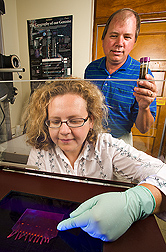This page has been archived and is being provided for reference purposes only. The page is no longer being updated, and therefore, links on the page may be invalid.
|
Read the magazine story to find out more. |
|
|
|
|
Counting Eimeria Before They Hatch
By Rosalie Marion BlissFebruary 7, 2007
Agricultural Research Service (ARS) scientists have developed a rapid system for identifying which of several Eimeria species are present on a particular farm. Eimeria are single-celled protozoans that cause coccidiosis, a major intestinal disease of chickens.
Coccidiosis makes it difficult for the chickens to absorb feed and gain weight, resulting in economic losses of more than $600 million annually for U.S. poultry producers.
Distinguishing between the Eimeria species that commonly infect chickens has been a challenge because their egglike oocysts are nearly identical in appearance. Producers have commonly used anticoccidial compounds that kill multiple Eimeria species at once, regardless of how many may actually infect a farm. But the Eimeria species targeted by these all-in-one anticoccidial drugs develop resistance to the compounds. The new technique can help producers fine-tune which drugs or vaccines to use in a particular poultry facility.
Microbiologist Mark Jenkins and molecular biologist Kate Miska, both with the ARS Animal Parasitic Diseases Laboratory in Beltsville, Md., developed a method that involves isolating Eimeria oocysts from poultry litter. Combining this process with PCR (polymerase chain reaction) technology enables researchers to identify which Eimeria species are present.
The new method will enable poultry producers to quickly determine which of seven Eimeria species are present on a farm. That knowledge will help them use just the right combination of vaccine and anticoccidial treatment to protect their flocks.
The system was described in the journal Avian Diseases.
Read more about this research in the February 2007 issue of Agricultural Research magazine.
ARS is the U.S. Department of Agriculture's chief scientific research agency.

